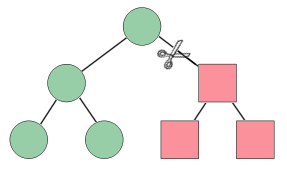HitTestFilterCallback Delegato
Definizione
Importante
Alcune informazioni sono relative alla release non definitiva del prodotto, che potrebbe subire modifiche significative prima della release definitiva. Microsoft non riconosce alcuna garanzia, espressa o implicita, in merito alle informazioni qui fornite.
Rappresenta il metodo di callback che specifica le parti della struttura ad albero visuale da omettere dall'elaborazione dell'hit test.
public delegate System::Windows::Media::HitTestFilterBehavior HitTestFilterCallback(DependencyObject ^ potentialHitTestTarget);public delegate System.Windows.Media.HitTestFilterBehavior HitTestFilterCallback(DependencyObject potentialHitTestTarget);type HitTestFilterCallback = delegate of DependencyObject -> HitTestFilterBehaviorPublic Delegate Function HitTestFilterCallback(potentialHitTestTarget As DependencyObject) As HitTestFilterBehavior Parametri
- potentialHitTestTarget
- DependencyObject
Oggetto visivo per l'hit test.
Valore restituito
Oggetto HitTestFilterBehavior che rappresenta l'azione risultante dell'hit test.
Esempio
Nell'esempio seguente viene illustrato come richiamare HitTest usando un HitTestFilterCallback valore. Viene definito anche il metodo di callback di hit test corrispondente.
// Respond to the mouse wheel event by setting up a hit test filter and results enumeration.
private void OnMouseWheel(object sender, MouseWheelEventArgs e)
{
// Retrieve the coordinate of the mouse position.
Point pt = e.GetPosition((UIElement)sender);
// Clear the contents of the list used for hit test results.
hitResultsList.Clear();
// Set up a callback to receive the hit test result enumeration.
VisualTreeHelper.HitTest(myCanvas,
new HitTestFilterCallback(MyHitTestFilter),
new HitTestResultCallback(MyHitTestResult),
new PointHitTestParameters(pt));
// Perform actions on the hit test results list.
if (hitResultsList.Count > 0)
{
ProcessHitTestResultsList();
}
}
' Respond to the mouse wheel event by setting up a hit test filter and results enumeration.
Private Overloads Sub OnMouseWheel(ByVal sender As Object, ByVal e As MouseWheelEventArgs)
' Retrieve the coordinate of the mouse position.
Dim pt As Point = e.GetPosition(CType(sender, UIElement))
' Clear the contents of the list used for hit test results.
hitResultsList.Clear()
' Set up a callback to receive the hit test result enumeration.
VisualTreeHelper.HitTest(myCanvas, New HitTestFilterCallback(AddressOf MyHitTestFilter), New HitTestResultCallback(AddressOf MyHitTestResult), New PointHitTestParameters(pt))
' Perform actions on the hit test results list.
If hitResultsList.Count > 0 Then
ProcessHitTestResultsList()
End If
End Sub
Nell'esempio seguente viene illustrato come restituire un HitTestFilterBehavior valore da un metodo di callback del filtro di hit test.
// Filter the hit test values for each object in the enumeration.
public HitTestFilterBehavior MyHitTestFilter(DependencyObject o)
{
// Test for the object value you want to filter.
if (o.GetType() == typeof(Label))
{
// Visual object and descendants are NOT part of hit test results enumeration.
return HitTestFilterBehavior.ContinueSkipSelfAndChildren;
}
else
{
// Visual object is part of hit test results enumeration.
return HitTestFilterBehavior.Continue;
}
}
' Filter the hit test values for each object in the enumeration.
Public Function MyHitTestFilter(ByVal o As DependencyObject) As HitTestFilterBehavior
' Test for the object value you want to filter.
If o.GetType() Is GetType(Label) Then
' Visual object and descendants are NOT part of hit test results enumeration.
Return HitTestFilterBehavior.ContinueSkipSelfAndChildren
Else
' Visual object is part of hit test results enumeration.
Return HitTestFilterBehavior.Continue
End If
End Function
Commenti
Il metodo di callback del filtro hit test viene richiamato per tutti gli oggetti visivi mappati ai criteri di hit test, a partire dall'oggetto visivo specificato e decrescente attraverso il ramo dell'albero visivo. È possibile tuttavia decidere di ignorare determinate parti della struttura ad albero visuale che non si desidera elaborare nella funzione di callback dei risultati dell'hit test. Il valore restituito dalla funzione di callback del filtro dell'hit test determina il tipo di azione che deve essere eseguita dall'enumerazione degli oggetti visivi. Ad esempio, se si restituisce il valore , ContinueSkipSelfAndChildrenè possibile rimuovere l'oggetto visivo corrente e i relativi discendenti dall'enumerazione risultati del test di hit. Ciò significa che il metodo di callback dei risultati di hit test non visualizzerà questi oggetti nell'enumerazione.
Nota
L'eliminazione di oggetti dalla struttura ad albero visuale consente di ridurre la quantità di elaborazione durante la fase di enumerazione dei risultati dell'hit test.

Eliminazione di una struttura ad albero visuale
Metodi di estensione
| GetMethodInfo(Delegate) |
Ottiene un oggetto che rappresenta il metodo rappresentato dal delegato specificato. |
